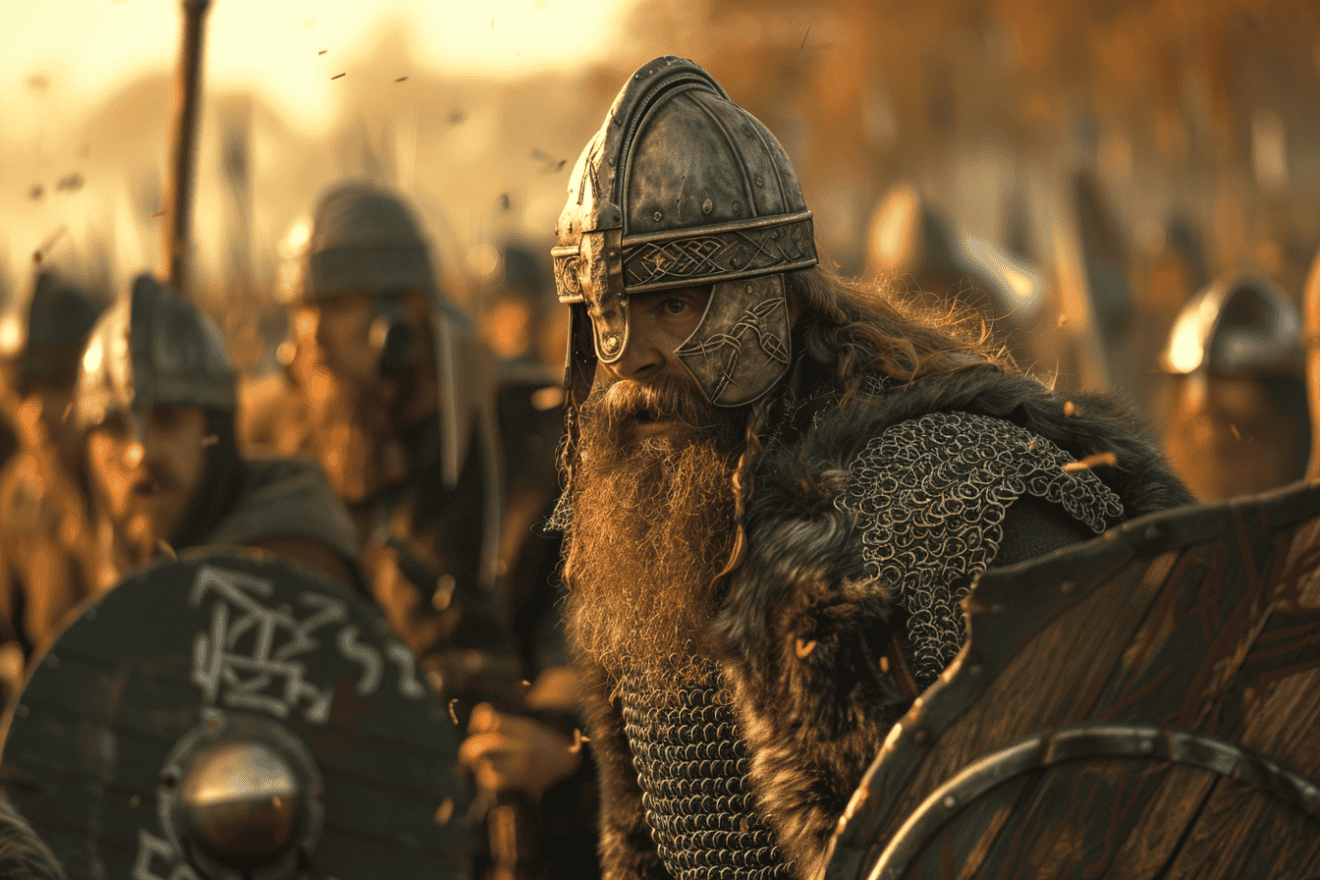As the Viking raids intensified, Wessex stood on the brink of collapse. Egbert, the kingdom’s stalwart defender, knew a decisive victory was essential to survival.
His strategic plan, combining fortifications, intelligence, and communication, would be put to the ultimate test at the Battle of Carhampton.
The fate of Wessex hung precariously, as the Viking forces, led by the cunning Olaf, closed in. With Egbert’s troops dug in and ready, the battle’s outcome would determine the course of history – but would it be enough to repel the Viking menace and secure Wessex’s future?
The Viking Menace Grows

By the mid-870s, Viking raids on England’s eastern coast had intensified, with the pagan warriors escalating their brutal attacks on monasteries, towns, and villages. The Vikings, driven by a desire for riches and plunder, targeted these vulnerable sites, leaving destruction and chaos in their wake.
Monasteries, with their treasured relics and stores of gold, were particularly attractive targets, and the Vikings showed no mercy as they pillaged and burned these sacred sites.
As the raids continued, the Vikings began to establish temporary settlements along the coast, providing a foothold for further conquest. The native populations, already reeling from the onslaught, were forced to adapt to the new reality of Viking presence. The once-peaceful regions of East Anglia and Northumbria were now hotbeds of violence and instability, as the Vikings’ iron grip tightened.
It was clear that the Viking menace was growing, and something had to be done to stop it.
Egbert’s Strategic Defense Plan

As the Viking threat loomed larger, Egbert, a seasoned military strategist, devised a thorough defense plan to counter the invaders and protect England’s vulnerable eastern coast. He knew that the key to success lay in fortifying the coastal towns and cities, and he set about strengthening the existing defenses. Earthen ramparts and wooden palisades were constructed to protect the settlements, while additional troops were deployed to reinforce the garrisons.
Egbert also recognized the importance of intelligence gathering, and he established a network of scouts and spies to monitor the Viking movements. This allowed him to anticipate their attacks and respond accordingly. Moreover, he implemented a system of beacons and messengers to rapidly convey information across the region, ensuring a swift response to any Viking incursion.
Egbert’s defense plan was a tribute to his military acumen, and it would ultimately prove instrumental in repelling the Viking threat. By combining strategic fortifications, effective intelligence, and rapid communication, Egbert had created a formidable barrier against the Viking invaders, and England’s eastern coast was finally ready to withstand the onslaught.
The Battle of Carhampton

One fateful morning in 845, Viking raiders descended upon the sleepy town of Carhampton, sparking a brutal battle that would test Egbert’s Strategic Defense Plan.
The Vikings, known for their swift raids, sought to plunder the town’s riches and claim its strategic location. Egbert, anticipating such an attack, had carefully prepared his defenses. His troops, well-trained and well-equipped, waited patiently behind the town’s fortified walls.
As the Viking raiders approached, Egbert’s archers released a hail of arrows, forcing the Vikings to take cover. The Vikings, undeterred, launched a series of fierce attacks, but Egbert’s defenses held strong. The battle raged on for hours, with both sides suffering heavy losses.
Despite being outnumbered, Egbert’s troops fought valiantly, buoyed by their leader’s tactical brilliance. As the day wore on, the Vikings began to falter, their attacks growing weaker and less coordinated. Sensing victory, Egbert’s troops launched a counterattack, driving the Vikings back and securing a vital victory for the town of Carhampton.
Olaf’s Cunning Ambush Tactics

Viking warlord Olaf concocted a sinister plan, leveraging his intimate knowledge of the countryside to set a trap for Egbert’s troops. He chose a narrow, winding pass near Carhampton, where the terrain would funnel the Wessex army into a killing zone. Olaf’s scouts had reported Egbert’s army was approaching, and the Viking warlord knew exactly how to exploit their formation.
He positioned his archers and skirmishers on the high ground, where they could rain down projectiles on the heavily armored Wessex troops. Meanwhile, Olaf’s elite warriors, the berserkers, lay in wait, ready to strike from the shadows.
As Egbert’s army marched into the pass, Olaf’s trap was sprung. The Wessex troops, caught off guard, found themselves struggling to maintain their formation amidst the hail of arrows and spear thrusts. The berserkers, with their frenzied battle cries, emerged from the woods, cutting down the disoriented Wessex soldiers.
The Viking ambush was a masterclass in tactics, and it seemed Olaf’s plan would succeed in crushing Egbert’s army. The fate of Wessex hung in the balance, as the outcome of the battle remained far from certain.
The Fate of Wessex Hangs

Egbert’s army teetered on the brink of collapse, its once-formidable lines now shattered and wavering under the relentless onslaught of Olaf’s ambush. The Viking leader’s cunning tactics had caught the Wessex forces off guard, and they were struggling to regroup.
As the battle raged on, the fate of Wessex hung precariously in the balance. If Egbert’s army fell, the entire kingdom would be exposed to the Viking’s merciless wrath.
The Anglo-Saxon Chronicle, a contemporaneous record of the time, describes the desperation of the Wessex forces: ‘The battle was fierce and bloody, and the army of Wessex was in dire straits.’ The Viking’s superior numbers and tactics had pushed Egbert’s men to the edge of defeat.
The fate of Wessex, and its people, rested on the shoulders of its beleaguered leader. Egbert’s stand was no longer just a battle against the Viking invaders; it was a fight for the very survival of his kingdom.
As the day wore on, the outcome of the battle, and the future of Wessex, remained uncertain.










Add Comment